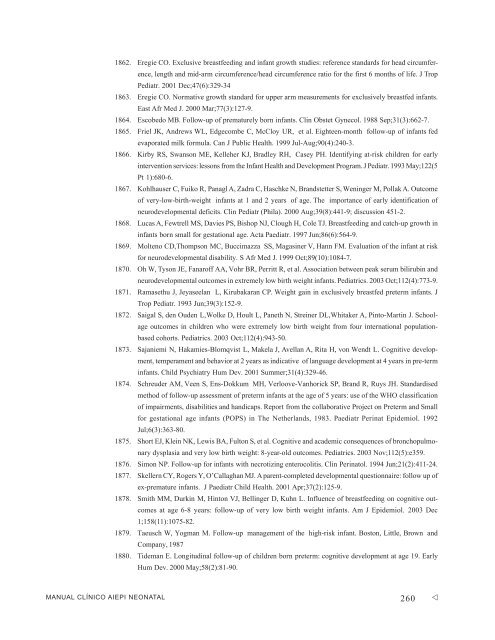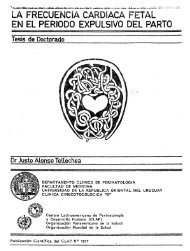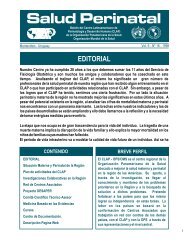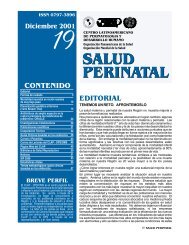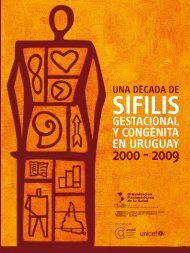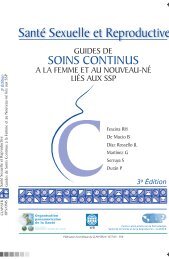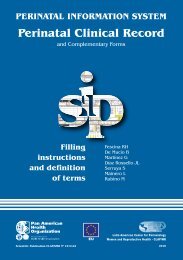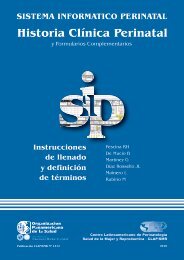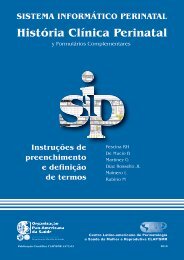Create successful ePaper yourself
Turn your PDF publications into a flip-book with our unique Google optimized e-Paper software.
1862. Eregie CO. Exclusive breastfeeding and infant growth studies: reference standards for head circumference,length and mid-arm circumference/head circumference ratio for the first 6 months of life. J TropPediatr. 2001 Dec;47(6):329-341863. Eregie CO. Normative growth standard for upper arm measurements for exclusively breastfed infants.East Afr Med J. 2000 Mar;77(3):127-9.1864. Escobedo MB. Follow-up of prematurely born infants. Clin Obstet Gynecol. 1988 Sep;31(3):662-7.1865. Friel JK, Andrews WL, Edgecombe C, McCloy UR, et al. Eighteen-month follow-up of infants fedevaporated milk formula. Can J Public Health. 1999 Jul-Aug;90(4):240-3.1866. Kirby RS, Swanson ME, Kelleher KJ, Bradley RH, Casey PH. Identifying at-risk children for earlyintervention services: lessons from the Infant Health and Development Program. J Pediatr. 1993 May;1<strong>22</strong>(5Pt 1):680-6.1867. Kohlhauser C, Fuiko R, Panagl A, Zadra C, Haschke N, Brandstetter S, Weninger M, Pollak A. Outcomeof very-low-birth-weight infants at 1 and 2 years of age. The importance of early identification ofneurodevelopmental deficits. Clin Pediatr (Phila). 2000 Aug;39(8):441-9; discussion 451-2.1868. Lucas A, Fewtrell MS, Davies PS, Bishop NJ, Clough H, Cole TJ. Breastfeeding and catch-up growth ininfants born small for gestational age. Acta Paediatr. 1997 Jun;86(6):564-9.1869. Molteno CD,Thompson MC, Buccimazza SS, Magasiner V, Hann FM. Evaluation of the infant at riskfor neurodevelopmental disability. S Afr Med J. 1999 Oct;89(10):1084-7.1870. Oh W, Tyson JE, Fanaroff AA, Vohr BR, Perritt R, et al. Association between peak serum bilirubin andneurodevelopmental outcomes in extremely low birth weight infants. Pediatrics. 2003 Oct;112(4):773-9.1871. Ramasethu J, Jeyaseelan L, Kirubakaran CP. Weight gain in exclusively breastfed preterm infants. JTrop Pediatr. 1993 Jun;39(3):152-9.1872. Saigal S, den Ouden L,Wolke D, Hoult L, Paneth N, Streiner DL,Whitaker A, Pinto-Martin J. Schoolageoutcomes in children who were extremely low birth weight from four international populationbasedcohorts. Pediatrics. 2003 Oct;112(4):943-50.1873. Sajaniemi N, Hakamies-Blomqvist L, Makela J, Avellan A, Rita H, von Wendt L. Cognitive development,temperament and behavior at 2 years as indicative of language development at 4 years in pre-terminfants. Child Psychiatry Hum Dev. 2001 Summer;31(4):329-46.1874. Schreuder AM, Veen S, Ens-Dokkum MH, Verloove-Vanhorick SP, Brand R, Ruys JH. Standardisedmethod of follow-up assessment of preterm infants at the age of 5 years: use of the WHO classificationof impairments, disabilities and handicaps. Report from the collaborative Project on Preterm and Smallfor gestational age infants (POPS) in The Netherlands, 1983. Paediatr Perinat Epidemiol. 1992Jul;6(3):363-80.1875. Short EJ, Klein NK, Lewis BA, Fulton S, et al. Cognitive and academic consequences of bronchopulmonarydysplasia and very low birth weight: 8-year-old outcomes. Pediatrics. 2003 Nov;112(5):e359.1876. Simon NP. Follow-up for infants with necrotizing enterocolitis. Clin Perinatol. 1994 Jun;21(2):411-24.1877. Skellern CY, Rogers Y, O’Callaghan MJ. A parent-completed developmental questionnaire: follow up ofex-premature infants. J Paediatr Child Health. 2001 Apr;37(2):125-9.1878. Smith MM, Durkin M, Hinton VJ, Bellinger D, Kuhn L. Influence of breastfeeding on cognitive outcomesat age 6-8 years: follow-up of very low birth weight infants. Am J Epidemiol. 2003 Dec1;158(11):1075-82.1879. Taeusch W, Yogman M. Follow-up management of the high-risk infant. Boston, Little, Brown andCompany, 19871880. Tideman E. Longitudinal follow-up of children born preterm: cognitive development at age 19. EarlyHum Dev. 2000 May;58(2):81-90.MANUAL CLÍNICO AIEPI NEONATAL 260


